Pop Culture
What Does the New Netflix Series About Convicted Scammer Anna Delvey Get Right About the Art World? We Took a Deep Dive
Here's our guide to the wall candy and character cameos.
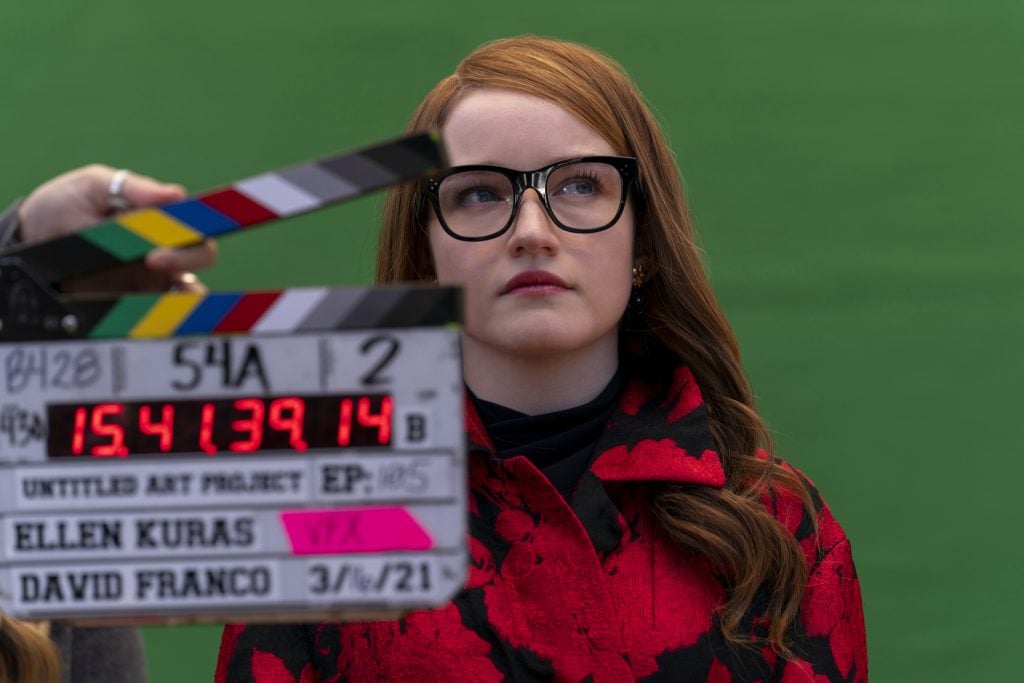
Here's our guide to the wall candy and character cameos.

Eileen Kinsella &
Katie White

Today, February 11, marks the release of the much-anticipated Netflix series Inventing Anna, about convicted con artist Anna Sorokin, aka Anna Delvey.
Having followed the high-profile case, including the criminal trial and beyond, since the story broke in 2018, Artnet News is of course curious to see how the Shonda Rimes-produced series portrays art-world characters and subplots. And the show does have an unusual mix of both true-to-life names and fictitious stand-ins.
For instance, top collector and real estate magnate Aby Rosen is referenced multiple times in the nine-episode series (though he remains an unseen character) as the owner of the SoHo hotel where the grifter parks herself for a months-long stay (though the name of the hotel in the show is 12 George, not the real-life 11 Howard). Rosen’s firm is also the real-life owner of 281 Park Avenue South, the historic building that Delvey unsuccessfully attempted to acquire for her eponymous foundation. (It’s now the home of the Swedish photography museum Fotografiska.)
Meanwhile, all signs indicate that a character who Anna dates early in the series, dubbed Chase Sikorski, is a pseudonym for Hunter Lee Soik, a so-called “futurist” and inventor of a spotty app about mining dreams called “Shadow,” which becomes “Wake” in the series.
As for artists, blue-chip names like Jeff Koons and Cindy Sherman are dropped alongside invented ones that make for a kind of guessing game and some sleuthing about who they’re supposed to represent IRL. Here are some other art-world cameos that caught our eye.
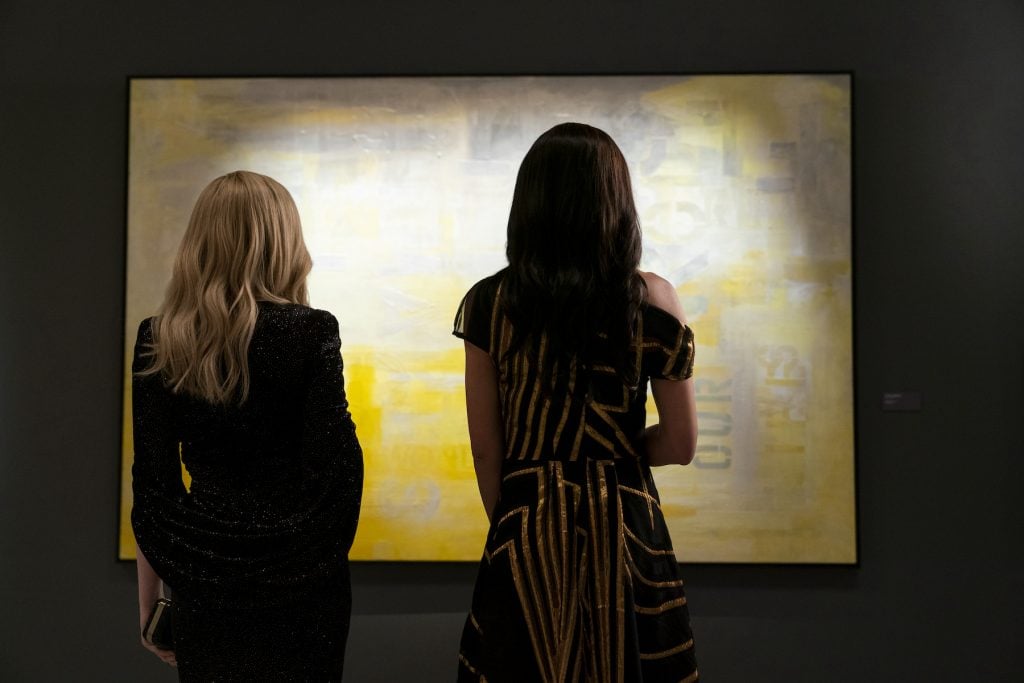
Julia Garner as Anna Delvey telling Talia Mallay, played by Marika Dominczyk, what not to buy at a gallery-meets-auction-house in episode two of Inventing Anna. Photo by Aaron Epstein/Netflix, ©2021.
It’s in the second episode of the series, “The Devil Wore Anna,” that the art world makes its first heavyweight appearance. Journalist Vivian Kent’s social-media stalking reveals that Anna is buddy-buddy with one Talia Mallay (Marika Dominczyk), an evidently famous lifestyle influencer and mogul in this fictitious world, we are meant to know. The duo was doing more than snapping selfies, with Anna acting as an impromptu art advisor, convincing Talia to purchase Cindy Sherman’s Untitled Film Still #17 (1978). Anna’s dialogue is littered with girl-boss takes on feminism in the age of the influencer, which proleptically applies to Sherman’s work.
“[O]ne day, she steps into her own frame, considers herself to be worthy. Rather than being forced into a role in the male-dominated art world, she takes a leading role in her work. And it changes the world. This is not dress-up. This is bravery. This is a moment in art,” Anna concludes. Talia, of course, buys the work on the spot, installing it in a guest bedroom of her Hamptons home.
Later on, when Vivian finds herself invited to spend the night in Talia’s extra-luxurious home after their interview runs long, she stares pensively, considering the Sherman, with an implied revelation about Anna’s masquerade as a brave act of self-invention.
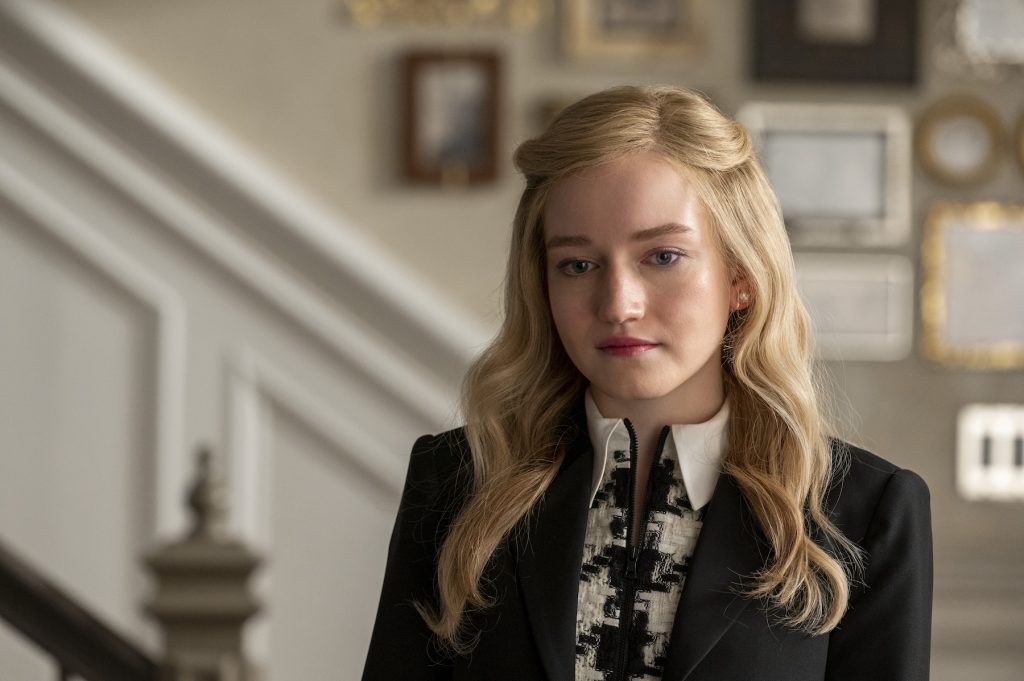
Julia Garner as Anna Delvey considering the work of fictional artist Polay. Image: David Giesbrecht/Netflix © 2021.
In episode three, “Two Birds, One Thrown” Anna and her boyfriend, Chase, are living in the town house of socialite Nora Radford (Kate Burton), who serves on the board of seven philanthropic organizations and has taken a shine to Chase. Thought initially critical of Anna (seemingly because Anna sleeps late), Nora begins to warm to her when she finds her admiring a work in her collection—a yellow abstract rectangle with gestures of blue.
“My Polay,” Nora remarks. “I got it at an auction in ‘97”
“Hmm…’97,” considers Anna. “That was before Polay was even in New York. Her Omaha days.”
“You’re a fan?” Nora asks, visibly surprised.
“Of her early work, yeah. But her new phase? The giant warehouse sculptures?” Anna scoffs. “You know what they say: When you’re out of new ideas, make your old ideas bigger.”
Anna-as-art-critic seems to impress Nora, who invites her along to Bergdorf’s for a private shopping event, where Anna begins to make inroads into Manhattan society’s upper echelon and learns that 281 Park Avenue South is on the market. “Can you imagine the art you could hang in there?” one of Nora’s friends remarks, as Anna furiously searches to learn more about the building on her phone.
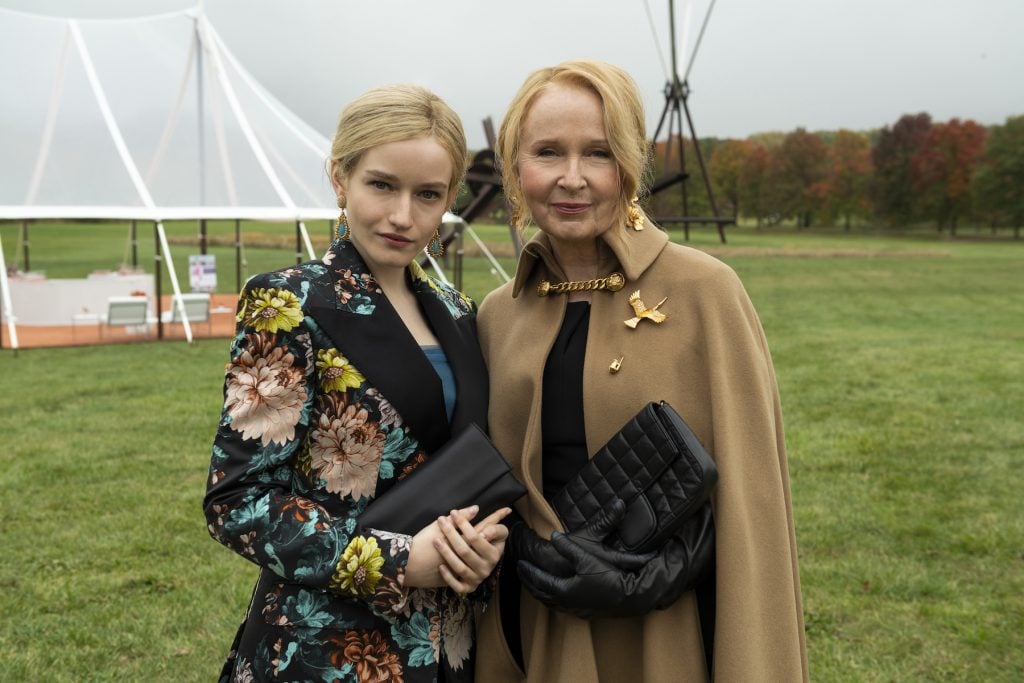
Behind the scenes with Kate Burton as Nora and Julia Garner as Anna Delvey at Storm King Art Center in Inventing Anna. Cr. David Giesbrecht/Netflix © 2021.
Later in episode three, after Anna has thrown Chase’s credibility into doubt with Nora, Nora decides to bring Anna with her to Storm King Art Center for an inner-city arts program fundraiser.
People in statement glasses stalk the grounds, snippets of art-speak wafting about. We hear: “a celebration of garbage as artifact”; “a juxtaposition of ambient soundscapes”; “immateriality in dialogue with transitory spaces”; and “a performance piece celebrating the color blue” as the attendees run off to grab free champagne. Art people, the show hammers down, are as full of baloney as Anna. There, Anna is introduced to a number of real and fictional art-world characters (more on that below). “The future isn’t just derivatives and moribund institutions from the last century,” Anna quips to her rapt audience, with works by Mark di Suvero and Zhang Huan looming in the background.
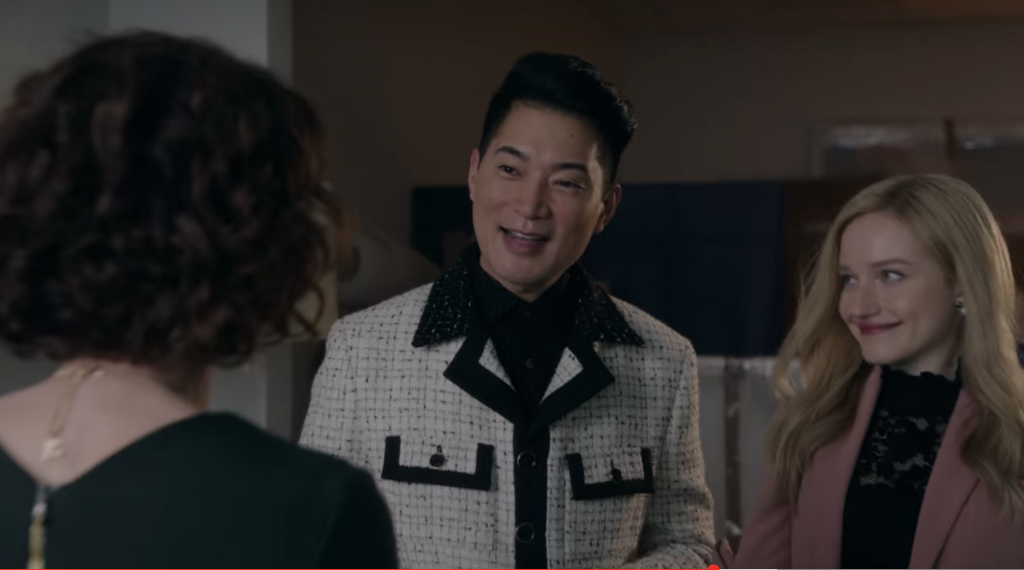
Michael Xufu Huang introducing Anna Delvey to art-world insiders in episode three. Image: Nicole Rivelli/Netflix © 2021.
Also at the Storm King party, Anna meets the young collector (now founder of the X Museum in Beijing) Michael Xufu Huang. People who had previously dismissed Delvey and her aspirations for a foundation start taking her more seriously once it’s clear she knows Huang. His name turns up again in a later episode, when the camera pans past a place setting with his name at a lavish restaurant dinner party hosted by Anna. That same ultimately unpaid-for dinner party was the reason the restaurant contacted the real-life Huang later on, asking him for Anna’s contact information since they spotted him in one of her social-media posts—as Huang related to New York magazine in an interview by Jessica Pressler (the basis for Vivian Kent in Inventing Anna) that resulted in the feature article that inspired the series.
More recently, Huang told Artnet News he realized something was afoot when many young Asian actors started following him on Instagram, and he realized it was because they were auditioning for his role in the Netflix series. Asked if he would watch the series, Huang told Artnet News it depended on whether the actor hired to portray him is “good looking.” (Huang was himself recently caught up in an embarrassing legal tussle—that has since settled—over his role in an art-flipping transaction that violated a gallery resale agreement.)
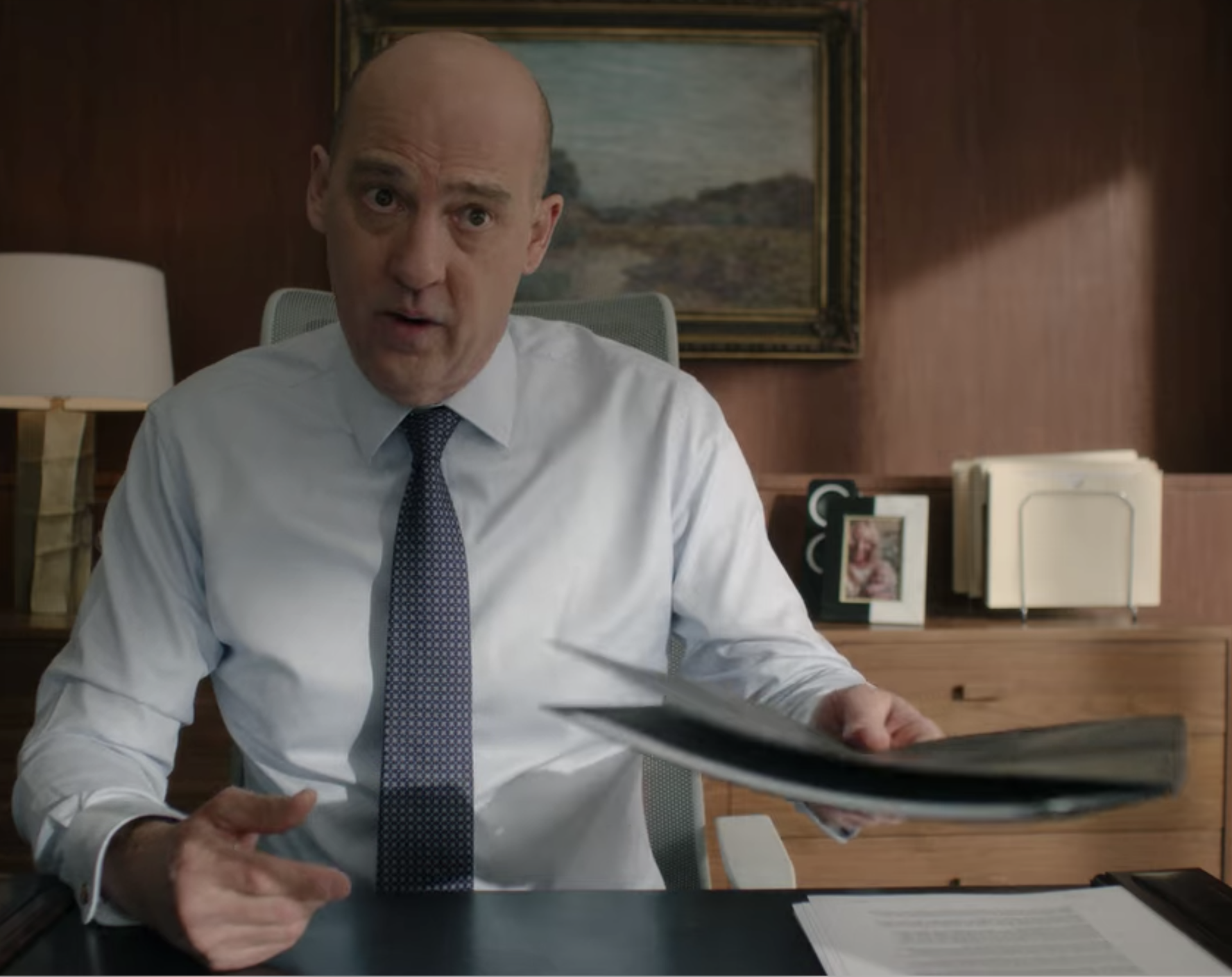
Anthony Edwards as Alan Reed, clutching the Anna Delvey Foundation proposal that makes a bevy of appearances throughout the series. Image: Nicole Rivelli/Netflix © 2021.
The detailed 80-page pitch that Delvey created to outline her larger-than-life plans for the foundation, and which was later introduced as evidence in her criminal trial, is practically its own character in the series. Viewers will frequently see the cover, with the initials ADF set on a black background, flashed around throughout the series. The admittedly impressive content and sleek design convinced a lot of characters, from hotel staff to powerful bankers, to take the project seriously. In it, Delvey gave details for the list of artists who could perhaps have rotating exhibitions there, including Daniel Arsham, Tara Donovan, Olafur Eliasson, Urs Fischer, Dan Flavin, Robert Irwin, Robert Longo, Helmut Newton, Irving Penn, Ed Ruscha, Robert Ryman. Richard Serra, Cindy Sherman, and James Turrell.
In the series, Anna tours the building with a high-profile group in tow, including a real estate broker, architect Gabriel Calatrava (Santiago’s son, played by Gabriel Sloyer), and a restaurateur (supposedly the owner of Nobu). She prattles on about creating a “dynamic visual arts” venue where “when you’re in, you know you’re special,” along with rotating exhibitions and installations of “the most interesting artists.” She designates one room as the future site of giant sculptures, “like a Doris Salcedo…huge pieces of art.” (Salcedo is a Colombian artist known for her massive installations.)
During Delvey’s trial, the London-based designer of the promotional folio told Artnet News that his own firm was conned out of thousands of dollars when Delvey failed to pay for the work his team invested in the project.

Julia Garner as Anna Delvey and Anthony Edwards as Alan Reed, shopping at the Whitney Museum in episode four. Image: Nicole Rivelli/Netflix © 2021.
In one inexplicable passage that suggests a connection to the Whitney Museum (the facade of the Meatpacking District building flashes at the opening of the scene), Anna is strolling through the galleries with Alan Reed (portrayed by Anthony Edwards), the powerful banker to whom she goes to great lengths to convince that she is, in fact, a German heiress with a $65 million fortune.
None of the art on display is actually recognizable, but one work, a semi-figurative jumble of bodies with a bright pink palette, is later seen being installed in Reed’s corporate office, a swap for a staid 19th-century landscape that Anna had frowned at when she first visited Reed’s office. “You don’t like the painting?” he asks, after observing her quizzical expression. What happened here? Did Reed go straight to the museum and buy the work? Did he approach the artist’s gallery after the Whitney visit? Did Anna make the acquisition possible? The details are never explained.

Katie Lowes as Rachel DeLoache Williams in episode six of Inventing Anna. Image: Nicole Rivelli/Netflix © 2021.
As it dawns on Anna that a $40 million loan for the Anna Delvey Foundation may fall through, she doubles down on excess, planning a lavish trip to Marrakech with her trainer, Kacy (Laverne Cox); pal Rachel DeLoache Williams (Katie Lowes), a Vanity Fair journalist; and a cameraman hired to film the vacation. With a variety of outlandish claims that her cards aren’t working overseas and that her money is tied up in German banks, Delvey convinces the overeager Williams to put the opulent five-star resort on her personal and work credit cards.
While Delvey is keen to stay at the resort (it’s all on Williams’s tab, after all), Williams convinces Delvey to visit the real-life Yves Saint Laurent Museum in Marrakech. “It’s kind of underwhelming. It’s just a bunch of cacti,” Delvey remarks of the famed gardens. The crew runs into trouble when it becomes apparent they can’t pay the price of admission—a whopping $2,000. While Delvey half-heartedly feigns reaching for her wallet, Williams is effectively held hostage by gruff museum guards until she figures out how to foot the bill. About those over-the-top museum ticket prices? “The donation benefits the Bergé-Saint Laurent Foundation in its efforts to preserve haute couture,” intones a haughty, caftan-clad docent.

Julia Garner as Anna Delvey imagining the Anna Delvey Foundation in 281 Park Avenue South. Image: Nicole Rivelli/Netflix © 2021.
As Anna’s schemes start crashing down, with an overdrawn bank account and her life spiraling out of control, her friends hold an intervention lunch where, over glasses of rosé, they demand answers about what’s really going on. As tension escalates and amid shouting and crying from Anna, one character slides her phone across the table and tells her that 281 Park Avenue South is gone, the lease signed to a competing renter—the aforementioned Swedish photography museum known as Fotografiska, which occupies the building today. Through her tears, Delvey looks down at the phone and whines: “That’s fake news!”